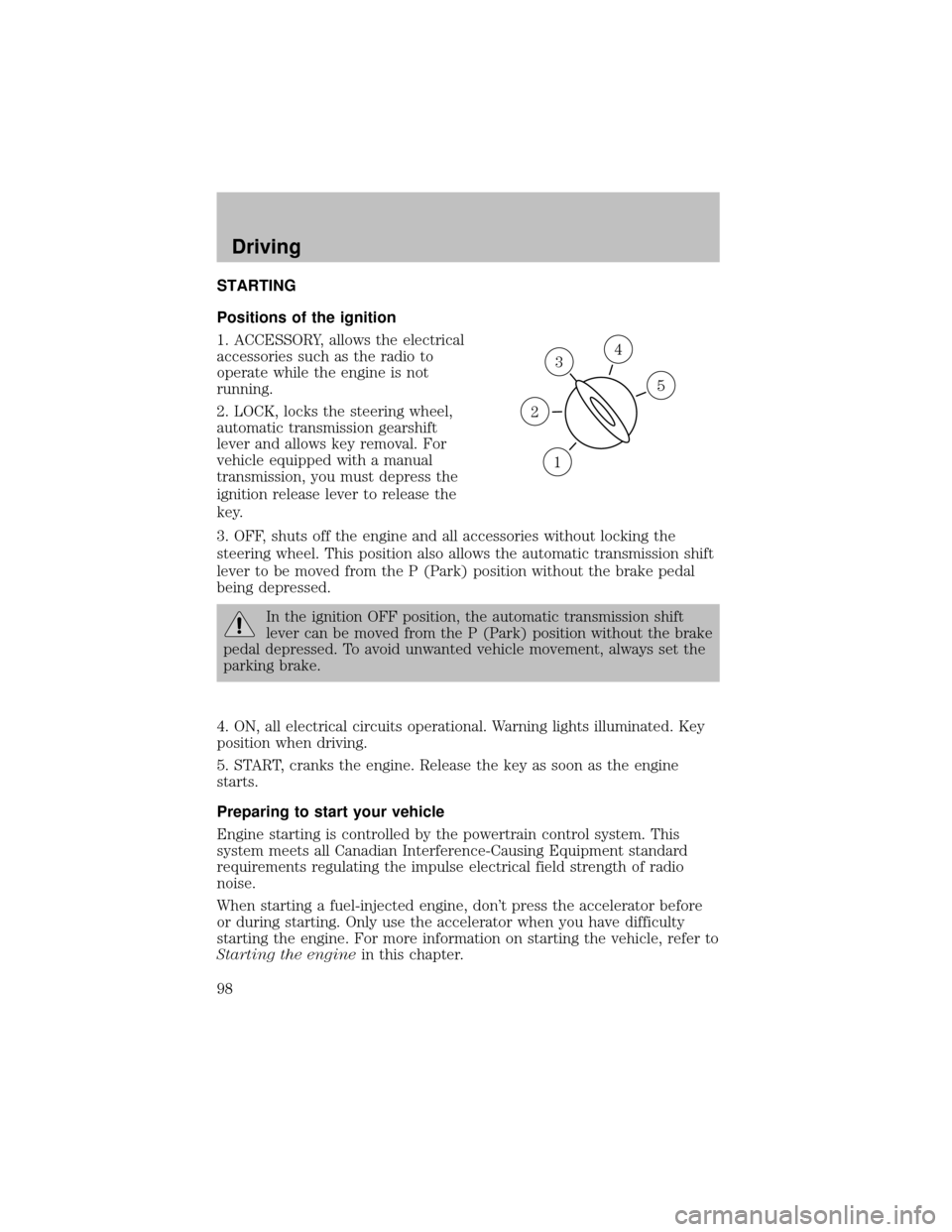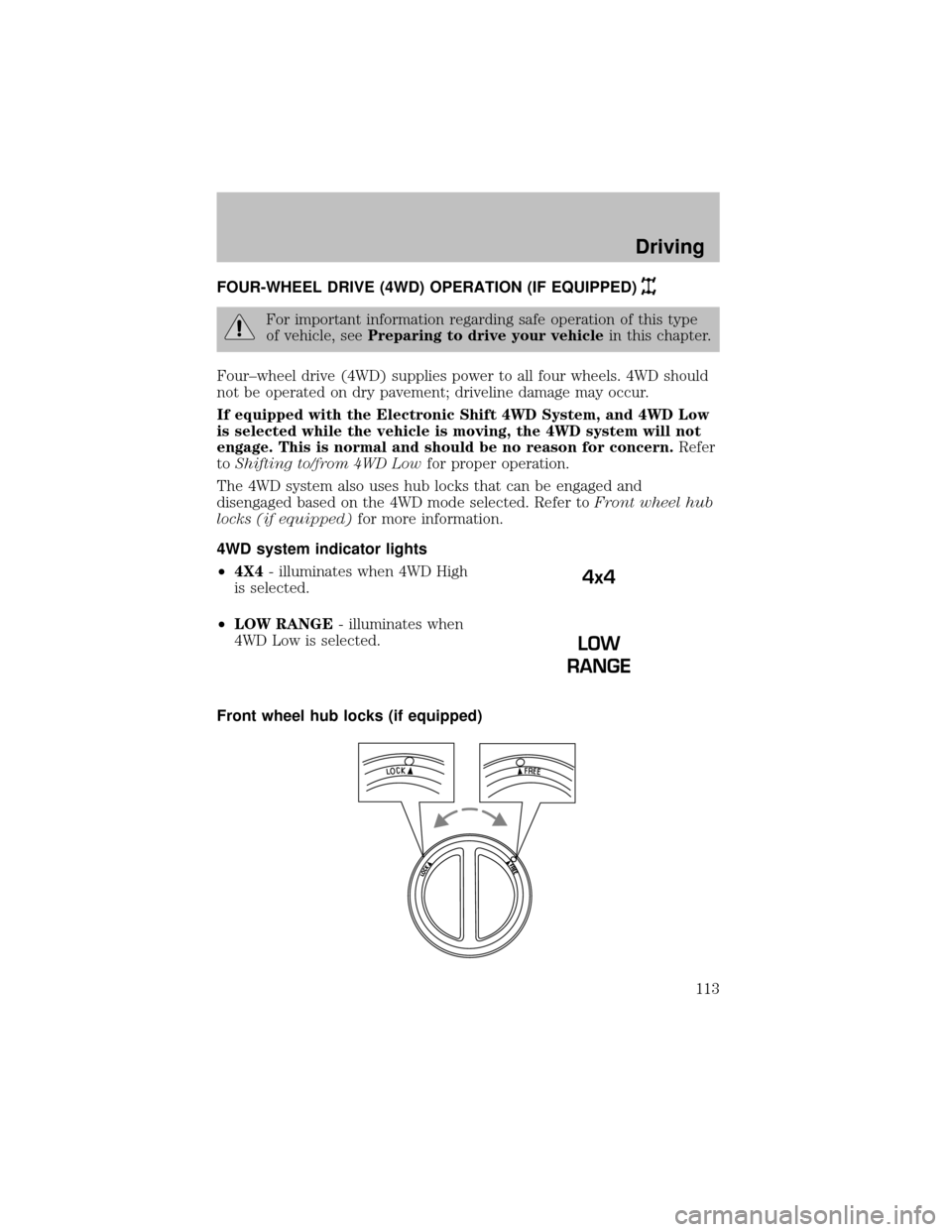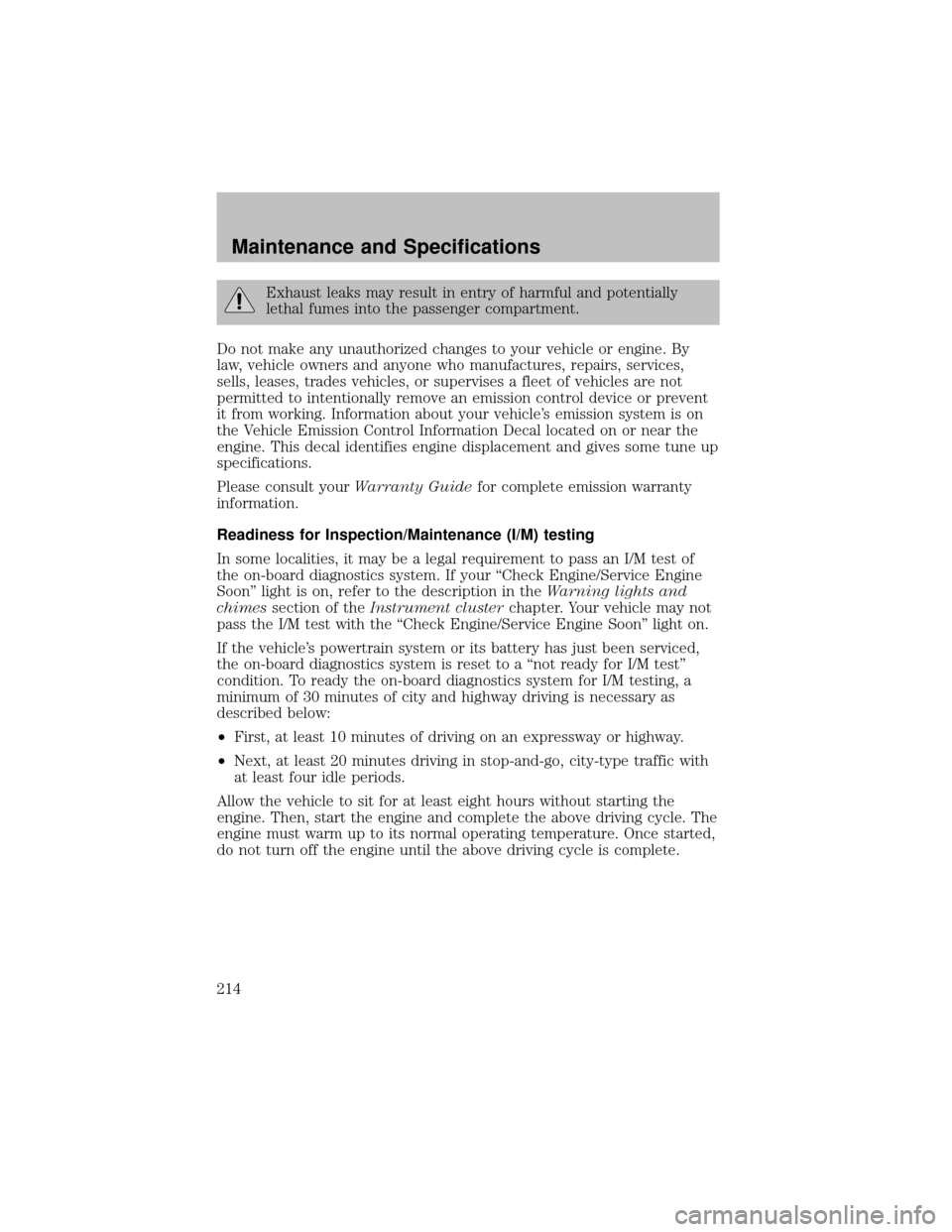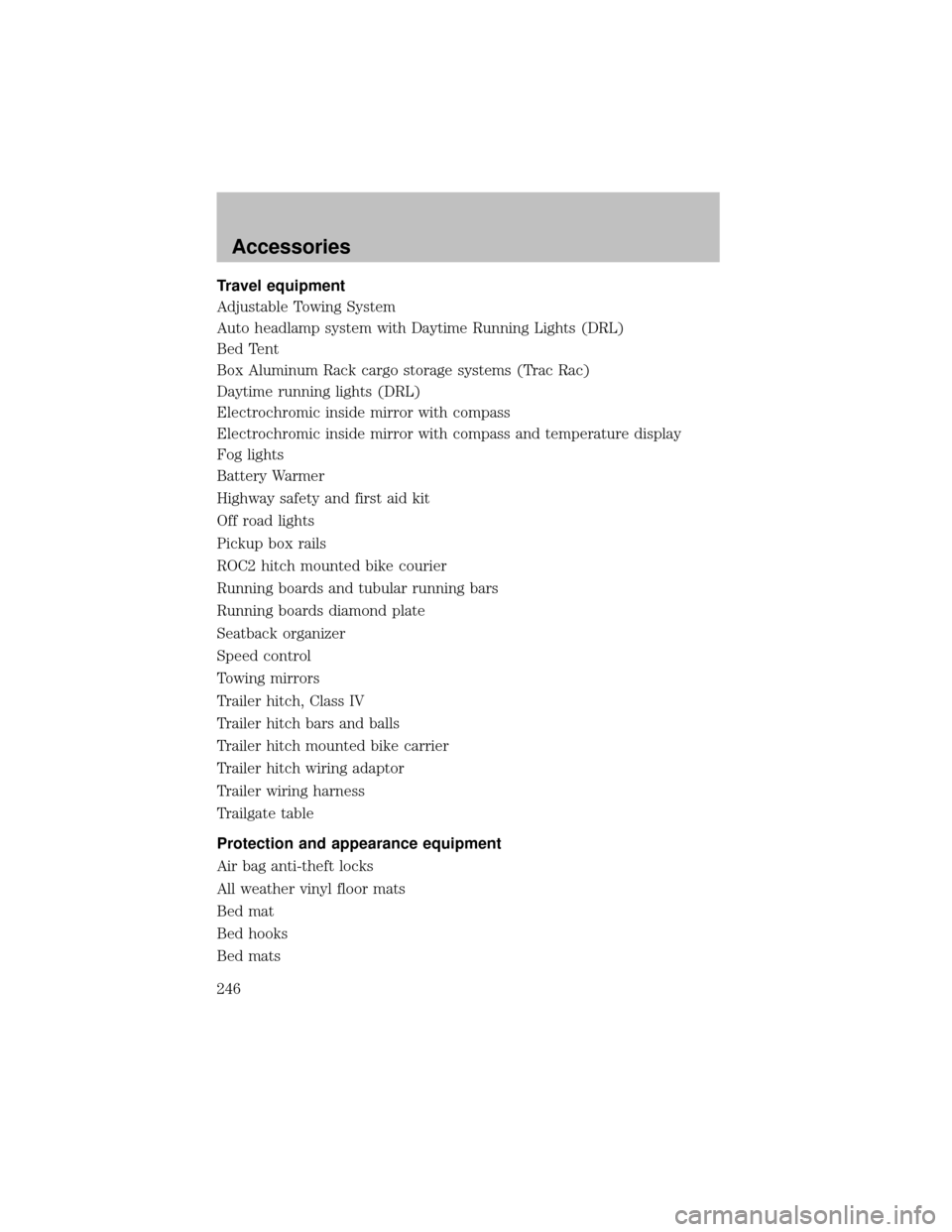2003 FORD SUPER DUTY lights
[x] Cancel search: lightsPage 98 of 256

STARTING
Positions of the ignition
1. ACCESSORY, allows the electrical
accessories such as the radio to
operate while the engine is not
running.
2. LOCK, locks the steering wheel,
automatic transmission gearshift
lever and allows keyremoval. For
vehicle equipped with a manual
transmission, you must depress the
ignition release lever to release the
key.
3. OFF, shuts off the engine and all accessories without locking the
steering wheel. This position also allows the automatic transmission shift
lever to be moved from the P (Park) position without the brake pedal
being depressed.
In the ignition OFF position, the automatic transmission shift
lever can be moved from the P (Park) position without the brake
pedal depressed. To avoid unwanted vehicle movement, always set the
parking brake.
4. ON, all electrical circuits operational. Warning lights illuminated. Key
position when driving.
5. START, cranks the engine. Release the keyas soon as the engine
starts.
Preparing to start your vehicle
Engine starting is controlled bythe powertrain control system. This
system meets all Canadian Interference-Causing Equipment standard
requirements regulating the impulse electrical field strength of radio
noise.
When starting a fuel-injected engine, don’t press the accelerator before
or during starting. Onlyuse the accelerator when you have difficulty
starting the engine. For more information on starting the vehicle, refer to
Starting the enginein this chapter.
3
1
2
5
4
Driving
98
Page 101 of 256

•Turn the keyto 4 (ON) without
turning the keyto 5 (START).
Make sure the corresponding lights illuminate or illuminate briefly. If a
light fails to illuminate, have the vehicle serviced.
•If the driver’s safetybelt is fastened, the
light maynot illuminate.
Starting the engine
1. Turn the keyto 4 (ON) without
turning the keyto 5 (START).
2. Turn the keyto 5 (START), then
release the keyas soon as the
engine starts. Excessive cranking
could damage the starter.
Note:If the engine does not start within five seconds on the first try,
turn the keyto 3 (OFF), wait 10 seconds and tryagain. If the engine still
fails to start, press the accelerator to the floor and tryagain; this will
allow the engine to crank with the fuel shut off in case the engine is
flooded with fuel.
1
2
34
5
3
2
1
5
4
Driving
101
Page 113 of 256

FOUR-WHEEL DRIVE (4WD) OPERATION (IF EQUIPPED)
For important information regarding safe operation of this type
of vehicle, seePreparing to drive your vehiclein this chapter.
Four–wheel drive (4WD) supplies power to all four wheels. 4WD should
not be operated on drypavement; driveline damage mayoccur.
If equipped with the Electronic Shift 4WD System, and 4WD Low
is selected while the vehicle is moving, the 4WD system will not
engage. This is normal and should be no reason for concern.Refer
toShifting to/from 4WD Lowfor proper operation.
The 4WD system also uses hub locks that can be engaged and
disengaged based on the 4WD mode selected. Refer toFront wheel hub
locks (if equipped)for more information.
4WD system indicator lights
•4X4- illuminates when 4WD High
is selected.
•LOW RANGE- illuminates when
4WD Low is selected.
Front wheel hub locks (if equipped)
4x4
Driving
113
Page 214 of 256

Exhaust leaks mayresult in entryof harmful and potentially
lethal fumes into the passenger compartment.
Do not make anyunauthorized changes to your vehicle or engine. By
law, vehicle owners and anyone who manufactures, repairs, services,
sells, leases, trades vehicles, or supervises a fleet of vehicles are not
permitted to intentionallyremove an emission control device or prevent
it from working. Information about your vehicle’s emission system is on
the Vehicle Emission Control Information Decal located on or near the
engine. This decal identifies engine displacement and gives some tune up
specifications.
Please consult yourWarranty Guidefor complete emission warranty
information.
Readiness for Inspection/Maintenance (I/M) testing
In some localities, it maybe a legal requirement to pass an I/M test of
the on-board diagnostics system. If your “Check Engine/Service Engine
Soon” light is on, refer to the description in theWarning lights and
chimessection of theInstrument clusterchapter. Your vehicle maynot
pass the I/M test with the “Check Engine/Service Engine Soon” light on.
If the vehicle’s powertrain system or its battery has just been serviced,
the on-board diagnostics system is reset to a “not ready for I/M test”
condition. To readythe on-board diagnostics system for I/M testing, a
minimum of 30 minutes of cityand highwaydriving is necessaryas
described below:
•First, at least 10 minutes of driving on an expresswayor highway.
•Next, at least 20 minutes driving in stop-and-go, city-type traffic with
at least four idle periods.
Allow the vehicle to sit for at least eight hours without starting the
engine. Then, start the engine and complete the above driving cycle. The
engine must warm up to its normal operating temperature. Once started,
do not turn off the engine until the above driving cycle is complete.
Maintenance and Specifications
214
Page 246 of 256

Travel equipment
Adjustable Towing System
Auto headlamp system with Daytime Running Lights (DRL)
Bed Tent
Box Aluminum Rack cargo storage systems (Trac Rac)
Daytime running lights (DRL)
Electrochromic inside mirror with compass
Electrochromic inside mirror with compass and temperature display
Fog lights
BatteryWarmer
Highwaysafetyand first aid kit
Off road lights
Pickup box rails
ROC2 hitch mounted bike courier
Running boards and tubular running bars
Running boards diamond plate
Seatback organizer
Speed control
Towing mirrors
Trailer hitch, Class IV
Trailer hitch bars and balls
Trailer hitch mounted bike carrier
Trailer hitch wiring adaptor
Trailer wiring harness
Trailgate table
Protection and appearance equipment
Air bag anti-theft locks
All weather vinyl floor mats
Bed mat
Bed hooks
Bed mats
Accessories
246
Page 251 of 256

refill capacities ........................228
specifications ..................232, 235
Exhaust fumes ..........................102
F
Fail safe cooling ........................204
Fluid capacities .........................228
Foglamps .....................................36
Four-Wheel Drive vehicles .......113
driving off road .......................116
electronic shift ................115–116
indicator light .........................113
lever operated shift ................114
manual locking hubs ..............113
preparing to drive your
vehicle .....................................105
Fuel ............................................205
calculating fuel economy.......210
cap ...........................................207
capacity...................................228
choosing the right fuel ...........208
comparisons with EPA fuel
economyestimates .................213
detergent in fuel .....................209
filling your vehicle
with fuel ..................205, 207, 210
filter, specifications ........209, 228
fuel pump shut-off switch .....153
improving fuel economy........210
octane rating ...................208, 235
quality......................................208
running out of fuel .................209
safetyinformation relating to
automotive fuels .....................205
Fuses ..................................154–155
G
Garage door opener ....................46Gas cap (see Fuel cap) ............207
Gas mileage
(see Fuel economy) .................210
Gauges .........................................13
GAWR (Gross Axle Weight
Rating) .......................................125
calculating ...............................127
definition .................................125
driving with a heavyload ......125
location ....................................125
GVWR (Gross Vehicle Weight
Rating) .......................................125
calculating .......................125, 127
definition .................................125
driving with a heavyload ......125
location ....................................125
H
Headlamps ...................................35
aiming ........................................37
autolamp system .......................35
daytime running lights .............36
flash to pass ..............................37
high beam .................................36
replacing bulbs .........................39
turning on and off ....................35
Heating
heating and air
conditioning system ...........32–33
Hood ..........................................192
I
Ignition .................................98, 235
Infant seats (see Safetyseats) ..90
Inspection/maintenance (I/M)
testing ........................................214
Index
251
Page 252 of 256

Instrument panel
cleaning ...................................187
cluster ........................................10
lighting up panel and
interior .......................................37
J
Jump-starting your vehicle ......168
K
Keyless entry system
autolock .....................................61
Keys
positions of the ignition ...........98
L
Lamps
autolamp system .......................35
bulb replacement
specifications chart ..................38
cargo lamps ...............................37
daytime running light ...............36
fog lamps ...................................36
headlamps .................................35
headlamps, flash to pass ..........37
instrument panel, dimming .....37
interior lamps ...........................38
replacing bulbs ...................38–43
Lane change indicator
(see Turn signal) ........................37
Lights, warning and indicator ....10
anti-lock brakes (ABS) ..........103
speed control ............................51
Load limits .................................125
GAWR ......................................125
GVWR ......................................125
trailer towing ..........................125
Loading instructions .................127Locks
autolock .....................................61
childproof ..................................57
Lubricant specifications ...232, 235
Lumbar support, seats ...............67
M
Manual transmission .................109
fluid capacities ........................228
lubricant specifications ..........235
reverse .....................................110
Message center ...........................51
english/metric button ...............52
menu button .............................52
Mirrors .........................................45
fold away...................................48
side view mirrors (power) .......47
Motorcraft parts ................209, 228
O
Octane rating ............................208
Oil (see Engine oil) ..................194
P
Parking brake ............................104
Parts (see Motorcraft parts) ....228
Pedals (see Power adjustable
foot pedals) .................................48
Power adjustable foot pedals .....48
Power distribution box
(see Fuses) ...............................155
Power door locks ..................56, 61
Power point .................................46
Power steering ..........................105
fluid, checking and adding ....215
Index
252
Page 254 of 256

fluid, checking and adding
(manual) .................................219
fluid, refill capacities ..............228
lubricant specifications ..232, 235
manual operation ....................109
Turn signal ..................................37
V
Vehicle dimensions ...................235
Vehicle Identification Number
(VIN) ..........................................244
Vehicle loading ..........................125
Ventilating your vehicle ...........102W
Warning lights (see Lights)
.......10
Washer fluid
..............................194
Water, Driving through
.............125
Windows
power
.........................................47
Windshield washer fluid and
wipers
..........................................44
checking and adding fluid
.....194
replacing wiper blades
.............44
Wrecker towing
.........................173
Index
254